If you’re new to trout fishing and want to get started using artificial baits, there is no better lure to begin with than the humble spinner. The spinner was conceived by French engineer Andre Meulnart on the trout rivers of the French Alps and later adopted and mass produced in the U.S. by Todd Sheldon.
The spinner has become a timeless lure with a reputation to match. Whether you call it a Roostertail, Panther Martin, or MEPPs, the spinner is cheap, easy to use, and practical. I doubt there is an angler alive today that has not had a spinner in their tackle boxes at some point, and there is good reason for it. The spinner remains one of the single most effective fishing lures ever created. From the tackle you use, the size of the lure, and the type of retrieve you perform, the spinner is a highly versatile and nuanced lure that can help you land that trophy trout you’ve been after for years.
Table of Contents
Why are Spinners so effective for trout?
Trout, like all fish species, have a specialized organ called the lateral line that runs the length of their bodies. This organ has evolved to pick up vibrations in the water column that indicate danger or potential prey. Trout have also developed incredible monocular and binocular color vision making them adept hunters regardless of water quality and light conditions. The spinner stimulates these extraordinary senses and often elicits a strike even if the trout isn’t hungry. The flash of the blade through the water mimics a floundering baitfish or insect, while the blade’s spinning vibration reinforces the deception that the lure is, indeed, a prey item. Together these two aspects make the spinner lure nearly irresistible to an aggressive trout and at least worth a closer inspection by more wary specimens.
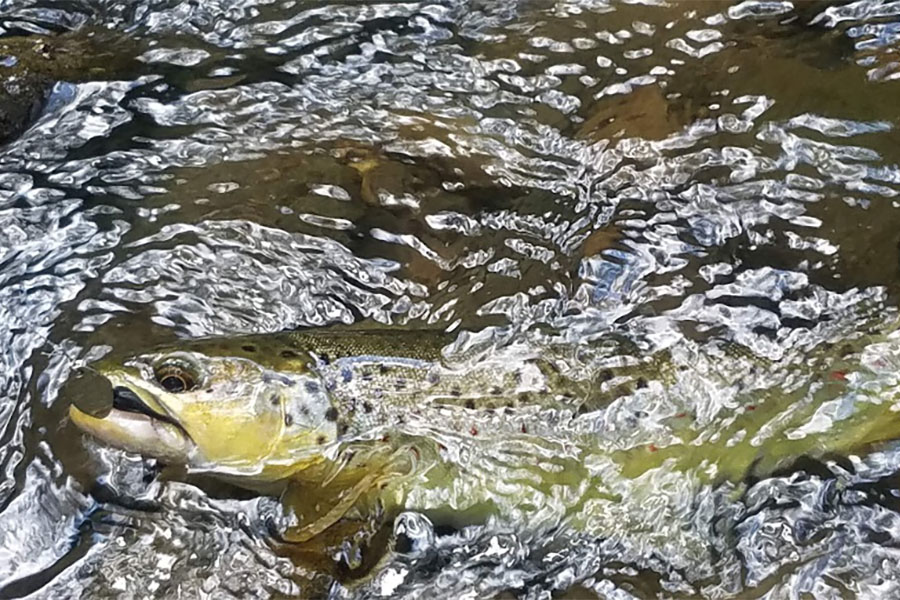
What Tackle to Pair and Rig with Spinners
A good rule of thumb when fishing for trout, especially in smaller creeks and streams, is to use the most lightweight tackle you can feasibly get away with. My go-to spinner set up for trout is typically a 3000-size spinning reel with 8-12lb braided line, 3-4ft fluorocarbon leader paired with a 6-8ft light action fishing rod with a soft tip. If you have not guessed by now, the name of the game is lightweight tackle; you can use a baitcaster, but unless the lure is at least 1/8oz, I wouldn’t advise it unless you love fixing backlash.
Table 1: A general guide to the sizes of line lure based on the conditions. Color is entirely up to the angler. Rod type for all data below is a 7ft light-medium action rod with a soft tip.
Reel size(Spinning)Mainline(Braid)Leaderline(Floro)Spinner SizeWaterConditionsTrout Expected1000-30008-12lbn4-6lbn1/32 oz; 1/16 oz; 1/8 oz1-5ft, light currentSmall to Medium size Rainbow, Brook, and Brown Trout1000-300010-12lb6-8lb1/4 oz; 1/4 oz1-10ft, light to heavy currentMedium to Large size Rainbow, Brook, and Brown Trout3000+10-12lb6-8lb1/4 oz; 1/4 oz1-10ft, light to heavy currentMedium to Large size Rainbow, Brook, and Brown Trout3000+12+lb8-12lb3/4 oz; 1 oz1-10ft, light to heavy currentMedium to Large size Rainbow, Brook, and Brown Trout
Tackle
1. Spinning reel: size 1000-3000
1000 to 3000 sizes of spinning reels are typically compact, light, and more than capable of handling large trout even in fast current. The reel brand is entirely up to the angler, and I would advise avoiding plastic-bodied reels with plastic handles. Remember, in the world of retail fishing, if it feels cheap, it probably is cheap. Typically higher-quality gear will have aluminum, steel, or carbon-fiber reel handles and bodies. My current favorite reel to use with spinners is a Daiwa Legalis 3000 LT.
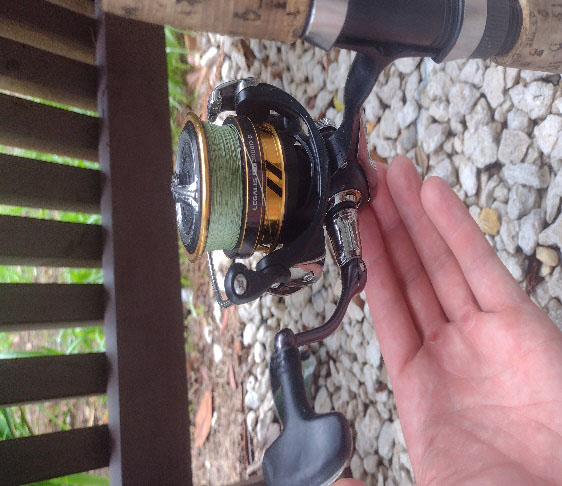
2. Spinning Rod: 5-8ft Light to Light-Medium action
Longer rods will allow longer casts and more maneuverability around rocks and boulders, while a shorter rod can be used for quicker, more precise casting. Because I like to fish rivers with dense shoreline cover, I typically choose shorter, more maneuverable rods that won’t get hung up in trees and limbs.
3. Line: 8-12lb braid with a 4-6lb fluorocarbon leader
The light braid will give you substantially more casting distance without sacrificing line strength. The fluorocarbon leader is nearly invisible in the water and will not spook away wary trout.
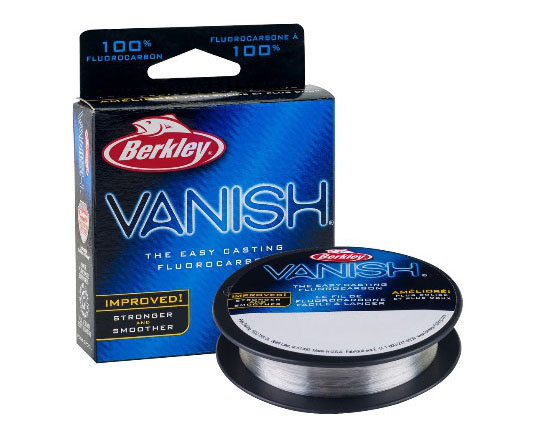
4. Lure Size and Weight: 1/32 to 1 oz
Lure weight and size depend entirely on depth, wind conditions, size of fish targeted, fish species, and the type of water being fished. A solid middle ground for all types of water is a 1/8 oz spinner. Remember that lure size does matter when attempting to target larger fish regardless of what people tell you. Animals can determine whether a prey item is worth their time for the energy they expend to retrieve it. Although you can find cases of small fishing hitting big lures and vice versa, typically, larger lures will entice larger fish. This is why Muskie spinners are nearly the size of your hand, while trout spinners can be smaller than your pinky fingernail.
Color of Spinner, Do Trout Care?
The color of the spinner’s body isn’t as important as you might think, regardless of what the trout fanatics and gurus tell you. Spinners are primarily causing reactionary strikes with trout due to the combination of flash and vibration. Therefore, when changing lures, it’s more prudent to change the blade style and color instead of the lure’s body color. Changing the blade color, alters the flash color and vibration that the spinner is expending into the water, which might be more enticing to that lethargic 20in brown your trying not to “accidentally” snag in the face after your 100th cast at it.
Typically I use darker colors during clear days and brighter colors on overcast days. Regardless of this guideline, however, I have been mistaken before. So take this advice with a pinch of salt. Tip: My favorite color and size when exploring a new creek or river is a 1/16oz Rooster-tail with a bronze blade.
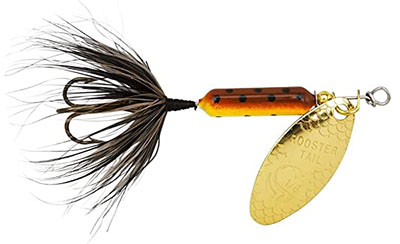
How to Rig a Spinner for Trout Fishing
As the name implies, spinners spin. Unfortunately, this sometimes causes the line to spin as well. We use a fluorocarbon leader attached to the braid with a swivel to prevent this. The swivel will allow the leader line to spin while preventing the mainline from turning. Although this isn’t required, it will help avoid tangles and loops forming in your mainline, which can be a real pain in the neck.
When spinner fishing for you trout, you can use a standard spinner rig setup. Tie the mainline (braid) to the fluorocarbon leader using a barrel swivel. Attached the mainline and fluorocarbon leader to the swivel using an improved clinch knot or palomar knot. Allow for 1′ to 2′ of leader line between the swivel and your spinner bait.
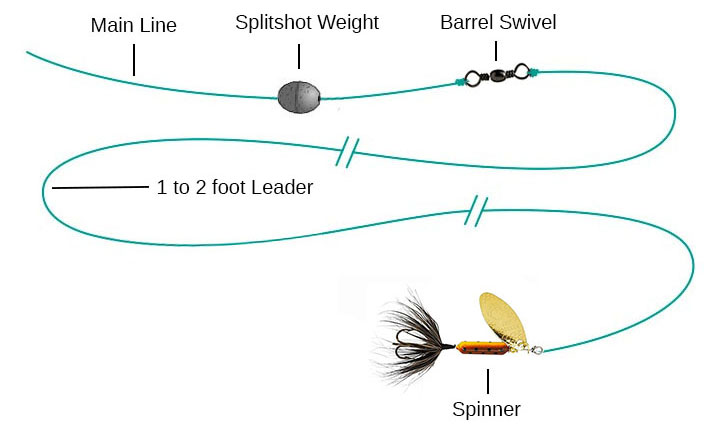
Tip: To remove twists from the line remove all tackle from the terminal end of the line and free-spool out as much line as possible into the current or behind a boat. This will naturally allow the line to untwist itself.
How and Where to use a Spinner for Trout
Retrieval Rate
Your retrieval rate is an important aspect you must be aware of when spinner fishing for trout. All spinners have a minimum retrieval rate that will allow the spinner to rotate freely like a boat propeller and not just flop around in the water. To use a spinner the most effectively, you want to maintain the slowest retrieval that your spinner will allow as you propel it through the water.
All brands, blade sizes, shapes, and weights of spinners are different, and finding the optimal retrieval rate for each one is imperative. To get an idea of your spinners’ optimal retrieval rate, drag the lure a few feet in front of you until you see the blade engage and rotate like a small propeller. If it isn’t rotating, you can bend the blade’s edge using a pair of pliers or flatten it with a hammer or rock.
How to Fish a River with a Spinner for Trout
In a river, trout are typically in feeding lanes with their heads pointed into the current as they wait for wounded baitfish or insects to pass by them. These feeding lanes generally are found on drop-offs into deeper water or on the edge of eddies created by rocks or fallen timber. Rarely will they pursue a meal into the current to waste precious energy, highlighting the importance of proper positioning when you make your cast.
Always throw your spinner at roughly a 45-degree angle up-current to allow it to swing through areas where you believe fish might be. Since we know the general direction in a river that trout will face, it’s also prudent to walk upriver instead of downriver when bank fishing. This way, you walk up behind fish instead of in their line of sight. You’ll find you spook less fish and catch more this way.
How to Fish a Lake with a Spinner for Trout
In lakes, trout are much more susceptible to atmospheric changes than in rivers. During the hottest and coldest months of the year, you will typically find them in deeper water and difficult to target by the shore. During the Spring and Fall, trout will hunt along the shorelines, looking for insects, amphibians, and small fish that stray too far into the open. These are the optimal times to throw spinners for trout in a lake. Keep the spinner just a few feet above the bottom, maintaining a continuous retrieval casting toward the structure or the bank. Try to fish drop-offs, structures, and vegetation where the trout’s natural prey may be hiding.
Final Note: Brown vs. Rainbow Trout
Typically, when fishing for trout in the U.S., you will find yourself in waters stocked with Brown or Rainbow trout. Both species of fish have variable habits that, once known, can help you identify areas where you are more likely to catch either species. Brown trout love the dense cover of fallen logs and shorelines with overhangs where they can ambush small animals, fish, and insects as they fall into the water.
Although you can find rainbows exhibiting similar behavior until they reach a particular size class, I tend to find rainbows in deeper, calmer water. Brown trout are also more aggressive and prefer hunting smaller trout and fish, while rainbows, especially hatchery fish, prefer bugs, nymphs, and larvae. I know…I know, you have caught giant brown trout on size 20 nymphs and swear by it. However, from my experience, larger spinners with wider blades tend to catch more brown trout than rainbows.
Till next time, good luck and tight lines.








































